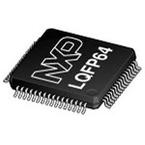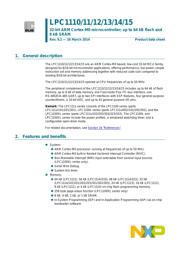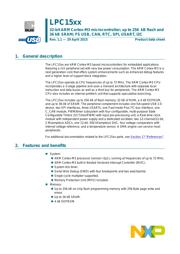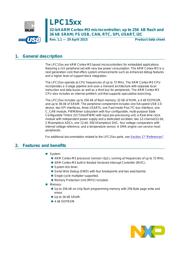Part Datasheet Search > 32 Bit Microcontroller > LPC1549 Datasheet PDF

Images are for reference
LPC1549 Datasheet PDF
Part Series:
LPC1549 Series
Category:
32 Bit Microcontroller
Description:
NXP LPC1549JBD64QL 32Bit Microcontroller, ARM Cortex-M3, 72MHz, 256KB, 36KB, 64Pins, LQFP
Updated Time: 2023/01/13 02:22:08 (UTC + 8)
LPC1549 32 Bit Microcontroller Datasheet PDF
LPC1549 Datasheet PDF 32 Bit Microcontroller
107 Pages
NXP
NXP LPC1549JBD100 32Bit Microcontroller, ARM Cortex-M3, 72MHz, 256KB, 36KB, 100Pins, LQFP
107 Pages
NXP
NXP LPC1549JBD48 32Bit Microcontroller, ARM Cortex-M3, 72MHz, 256KB, 36KB, 48Pins, LQFP
LPC1549JBD64QL - NXP Specifications
TYPE
DESCRIPTION
Mounting Style
Surface Mount
Frequency
72 MHz
Number of Pins
64 Pin
Supply Voltage (DC)
2.40V (min)
Case/Package
LQFP-64
show more
LPC1549JBD64QL - NXP Function Overview
●Overview
●The LPC1500 microcontroller series are optimized for fast, easy, and high-precision motor control and incorporate all the features required for high-accuracy sensored and sensorless motor control, enabling simultaneous control of two motors in highly flexible configurations. Based on the ARM® Cortex™-M3 processor, the LPC1500 microcontroller series has two 12-bit, 12-channel, 2 Msps ADCs and an on-chip quadrature encoder interface (QEI) to enable highly accurate control of both sensored and sensorless motor combinations. Four on-chip comparators enable fast-response over-current/voltage monitoring and protection; and four flexible SCTimer/PWM timers provide up to 28 PWM channels in a tightly coupled analog and timing subsystem, with minimal load on the CPU. Ideal for use with a wide range of brushless DC (BLDC) motors, permanent-magnet synchronous motors (PMSM), and AC induction motors (ACIM) commonly found in products such as large home appliances, HVAC, industrial pumps and generators, and more. They are also well suited for industrial applications requiring high-precision data sampling and real-time control, such as digital power and instrumentation. The LPC1500 series of microcontrollers are fully supported by the LPC software ecosystem and an extensive collection of tools, drivers and middleware.
●With ultra-efficient motor control firmware, easy-to-use GUI-based tuning tools, and two new motor control solution kits, NXP LPC1500 microcontrollers simplify evaluation and development of motor control applications, without requiring deep motor control experience.
●MoreLess
●## Features
● System:
● ARM Cortex-M3 processor, running at frequencies of up to 72 MHz.
● ARM Cortex-M3 built-in Nested Vectored Interrupt Controller (NVIC).
● System tick timer.
● Serial Wire Debug (SWD) with four breakpoints and two watchpoints.
● Single-cycle multiplier supported.
● Memory Protection Unit (MPU) included.
● Memory:
● Up to 256 kB on-chip flash programming memory with 256 Byte page write and erase.
● Up to 36 kB SRAM
● 4 kB EEPROM.
● ROM API support:
● Boot loader with boot options from flash or external source via USART, C_CAN, or USB
● USB drivers
● ADC drivers
● SPI drivers
● USART drivers
● I²C drivers
● Power profiles and power mode configuration with low-power mode configuration option
● DMA drivers
● C_CAN drivers
● Flash In-Application Programming (IAP) and In-System Programming (ISP).
● Digital peripherals:
● Simple DMA engine with 18 channels and 20 programmable input triggers.
● High-speed GPIO interface with up to 44 General-Purpose I/O (GPIO) pins with configurable pull-up/pull-down resistors, open-drain mode, input inverter, and programmable digital glitch filter.
● GPIO interrupt generation capability with boolean pattern-matching feature on eight external inputs.
● Two GPIO grouped port interrupts.
● Switch matrix for flexible configuration of each I/O pin function.
● CRC engine.
● Quadrature Encoder Interface (QEI).
● Configurable PWM/timer/motor control subsystem:
● Up to four 32-bit counter/timers or up to eight 16-bit counter/timers or combinations of 16-bit and 32-bit timers.
● Up to 28 match outputs and 22 configurable capture inputs with input multiplexer.
● Dither engine for improved average resolution of pulse edges.
● Four State Configurable Timers (SCTimers) for highly flexible, event-driven timing and PWM applications.
● SCT Input Pre-processor Unit (SCTIPU) for processing timer inputs and immediate handling of abort situations
● Integrated with ADC threshold compare interrupts, temperature sensor, and analog comparator outputs for motor control feedback using analog signals.
● Special-application and simple timers:
● 24-bit, four-channel, multi-rate timer (MRT) for repetitive interrupt generation at up to four programmable, fixed rates.
● Repetitive interrupt timer for general purpose use and use with debug time-stamping.
● Windowed Watchdog timer (WWDT).
● High-resolution 32-bit Real-time clock (RTC) with selectable 1 s or 1 ms time resolution running in the always-on power domain. RTC can be used for wake-up from all low power modes including Deep power-down.
● Analog peripherals:
● Two 12-bit ADC with up to 12 input channels per ADC and with multiple internal and external trigger inputs and sample rates of up to 2 Msamples/s. Each ADC supports two independent conversion sequences. ADC conversion clock can be the system clock or an asynchronous clock derived from one of the three PLLs.
● One 12-bit DAC.
● Integrated temperature sensor and band gap internal reference voltage.
● Four comparators with external and internal voltage references (ACMP0 to 3). Comparator outputs are internally connected to the SCTimer/PWMs and ADCs and externally to pins. Each comparator output contains a programmable glitch filter.
● Serial interfaces:
● Three USART interfaces with DMA, RS-485 support, autobaud, and with synchronous mode and 32 kHz mode for wake-up from Deep-sleep and Power-down modes. The USARTs share a fractional baud-rate generator.
● Two SPI controllers.
● One I²C-bus interface supporting fast mode and Fast-mode Plus with data rates of up to 1Mbit/s and with multiple address recognition and monitor mode.
● One C_CAN controller.
● One USB 2.0 full-speed device controller with on-chip PHY.
● Clock generation:
● 12 MHz internal RC oscillator trimmed to 1 % accuracy for -25 °C ≤ Tamb ≤ +85 °C that can optionally be used as a system clock.
● Crystal oscillator with an operating range of 1 MHz to 25 MHz.
● Watchdog oscillator with a frequency range of 503 kHz.
● 32 kHz low-power RTC oscillator with 32 kHz, 1 kHz, and 1 Hz outputs.
● System PLL allows CPU operation up to the maximum CPU rate without the need for a high-frequency crystal. May be run from the system oscillator or the internal RC oscillator.
● Two additional PLLs for generating the USB and SCTimer/PWM clocks.
● Clock output function with divider that can reflect the crystal oscillator, the main clock, the IRC, or the watchdog oscillator.
● Power control:
● Integrated PMU (Power Management Unit) to minimize power consumption.
● Reduced power modes: Sleep mode, Deep-sleep mode, Power-down mode, and Deep power-down mode.
● APIs provided for optimizing power consumption in active and sleep modes and for configuring Deep-sleep, Power-down, and Deep power-down modes.
● Wake-up from Deep-sleep and Power-down modes on activity on USB, USART, SPI, and I²C peripherals.
● Wake-up from Sleep, Deep-sleep, Power-down, and Deep power-down modes from the RTC alarm or wake-up interrupts.
● Timer-controlled self wake-up from Deep power-down mode using the RTC high-resolution/wake-up 1 kHz timer.
● Power-On Reset (POR).
● BrownOut Detect BOD).
● JTAG boundary scan modes supported.
● Unique device serial number for identification.
● Single power supply 2.4 V to 3.6 V.
● Temperature range -40 °C to +105 °C.
● Available as LQFP64 package.
●## Target Applications
● Motor control
● Motion drives
● Digital power supplies
● Solar inverters
● Home appliances
● Building and factory automation
● Industrial and medical
●## Features
show more
Part Datasheet PDF Search
Example: STM32F103
Loading...
72,405,303 Parts Datasheet PDF, Update more than 5,000 PDF files ervery day.



